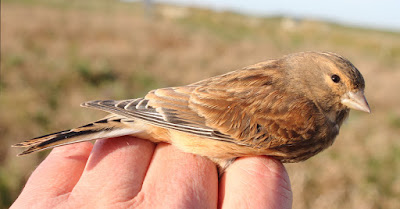I met up with Andy for another ringing session at Oakenclough. After three or four night of clear weather and sunny skies to help migration along it was perhaps too much to expect a large catch.
And so it proved with just 12 birds - 4 Goldfinch, 2 Lesser Redpoll, 2 Wren, 2 Blue Tit, 1 Siskin, 1 Chiffchaff.
Lesser Redpoll
The Chiffchaff was our first for the year here and although it was a male we did not hear it singing prior to it appearing in the net at 0900. By March 28th an early Willow Warbler might also be around. A cursory check revealed that appearance-wise our first “phyllosc” was clearly a Chiffchaff. On closer inspection primary 2= 7-8, and primary 6=emarginated, so therefore nothing but a Chiffchaff. It is not unknown that dull and dark-legged Willow Warblers can resemble a Chiffchaff, but also that Willow Warbler/Chiffchaff hybrids occur, even though they are very rare.
Chiffchaff
For phylloscopus enthusiasts and those with an interest in sub-species who may also enjoy scientific jargon, there was an interesting online paper recently. A dictionary will be useful to translate some of the terminology used by the authors. The paper is entitled “Patterns of genetic, phenotypic, and acoustic variation across a chiffchaff (Phylloscopus collybita abietinus/tristis) hybrid zone.” At http://onlinelibrary.wiley.com/doi/10.1002/ece3.2782/full
Ornithologists studied a “hybrid zone” in Europe where a number of subspecies of Chiffchaffs are known to occur and interbreed. The paper’s conclusion is perhaps far from surprising to most birders - a mix of genetic ancestry shows extensive ongoing and past gene flow with at least one of the previously described subspecies of Chiffchaff unlikely to be a distinct species.
Also, subspecies identification of Chiffchaffs in this region based (and probably elsewhere in its migration range! – my italics) on appearance is uncertain, as even an individual with apparently distinct looks such as “Siberian Chiffchaff”, can have a considerable proportion of its make-up hybridised from the other subspecies.
Birding wise this morning we noted 3 Pied Wagtail. Also a single Mistle Thrush in song, one Sand Martin dashed through on a northerly track north and then within a minute of each other saw both the male and female Sparrowhawks of the local pair.
Linking this post to Anni's Blog and Stewart's World Bird Wednesday.
Linking this post to Anni's Blog and Stewart's World Bird Wednesday.















































































